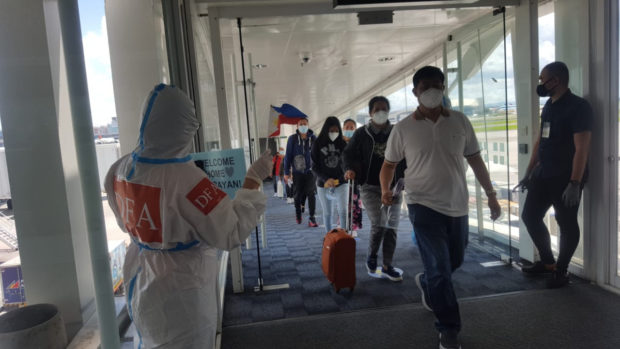
File photo from DFA
MANILA, Philippines — Despite restrictions imposed in the country amid the COVID-19 pandemic, the government is still expecting a huge number of arrivals this holiday season.
The Department of Transportation (DOTr) said it has been preparing for the anticipated holiday rush with a reminder to returning overseas Filipinos that they have to follow processes before and upon arriving in the Philippine soil.
Below are the procedures that all balikbayans should do prior to and at the time of arrival at the airport:
Register to E-CIF prior to departure from point of origin
Passengers should fill up the E-CIF (Electronic Case Investigation Form), which is necessary when undergoing health protocols, ahead of the flight to the Philippines.
According to the Philippine Red Cross (PRC), this form is important “to minimize the spread of COVID-19 into the Philippines through our ports of entry, It also ensures that anyone arriving into the country will be tested for COVID-19.”
At best, PRC suggests accomplishing the E-CIF at least three days prior to arrival in the country. Those who fail to fill out the form will be barred from passing through the immigration, it noted.
The form for arriving Overseas Filipino Workers (OFWs) is available on the PRC website.
DOTr Undersecretary Raul del Rosario said in an online forum on Wednesday that sea-based OFWs can sign up for E-CIF by the First Aide Laboratory (https://ecif.firstaide.ph/#/).
Non-OFWs, on the other hand, can get the E-CIF provided by Philippine Airlines (PAL).
Thermal scan and declaration forms upon arrival
PAL said arriving passengers shall undergo a temperature check and will also be asked to submit their Health Declaration Form upon deplaning or before proceeding to the designated waiting area.
Segregation of passengers and briefing
Del Rosario explained that once passengers enter the holding area, they will be segregated and briefed about the next steps they have to follow.
“Hihiwa-hiwalayin natin ang land-based, sea-based, at ang mga non-OFW,” he said.
(We will segregate them according to land-based, sea-based, or non-OFWs.)
Passenger information verification and swab testing
According to Del Rosario, before going through the RT-PCR (Reverse transcription-polymerase chain reaction) test, passengers should first verify their complete information.
“Ito po ay napaka-halaga para ma-check mabuti ang mga contact number at email addresses and mahahalagang information,” the DOTr official said.
(This is a very crucial step to thoroughly check the passengers’ contact numbers, email addresses, and other important information.)
“Kung magkakamali tayo ng nakuhang information ng mga pasahero natin, magkakamali rin ang pagpapadala ng mga result nila at pakikipag-ugnayan sa kanila,” he added.
(If we make an error in collecting their information, we will also have problems in delivering their RT-PCR test result.)
Thereafter, passengers can proceed to have their swab test done.
Bureau of Immigration counter
Before getting their baggage, PAL said passengers will pass through the Bureau of Immigration counter to submit their Arrival Cards.
Help desks
All arriving passengers also need to go to the stationed help desks to receive additional information regarding the mandatory 14-day quarantine procedure that they have to comply.
“Bago sila lumabas sa airport, dadaan sila sa mga help desk na nasa airport mismo. Dito po sila binibigyan ng mga kani-kanilang mga quarantine facility assignment,” said Del Rosario.
(Before leaving the airport, they need to stop by the help desks inside the airport. There, they will be assigned with their own quarantine facility assignment.)
Help desks of the Overseas Workers Welfare Administration (OWWA) will assist land-based passengers while the Maritime Industry Authority will assist sea-based passengers. The Department of Tourism will handle non-OFWs.
Transport to quarantine facility
After all procedures at the Ninoy Aquino International Airport are accomplished, OFW and non-OFW passengers will subsequently be transported to their assigned quarantine facilities via chartered transport facilities.
Del Rosario said that only OWWA buses, taxis with accreditation from the Manila International Airport Authority, and authorized hotel shuttles can fetch passengers from the airport and drop them at quarantine areas.
Release of RT-PCR test results and quarantine certificate
Del Rosario noted that the passengers will receive their RT-PCR test results within 24 to 48 hours.
“We can guarantee based on our past experiences na walang lumalabas na 48 hours sa ating turnaround time,” he said.
(We can guarantee based on our experience that our turnaround time will not exceed 48 hours.)
The quarantine certificate, meanwhile, given to passengers who has completed the 14-day quarantine.
Travel to final destination
Cleared OFWs and non-OFWs can finally go home or reach their destination through chartered flights and busses by OWWA.
The free transportation service is part of the government’s Balik Probinsya Program.
KGA
RELATED STORY
DOTr: Over 11K returning overseas Filipinos tested positive for COVID-19